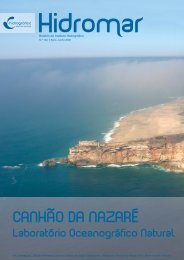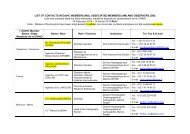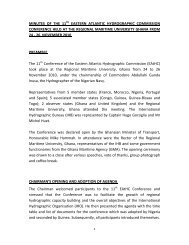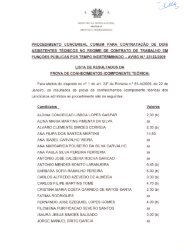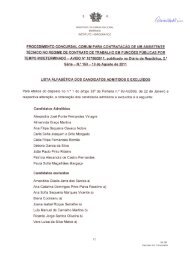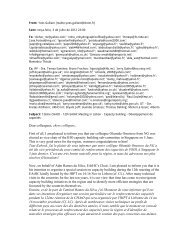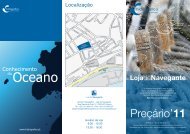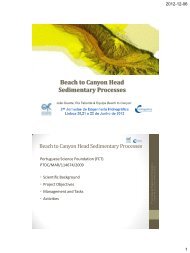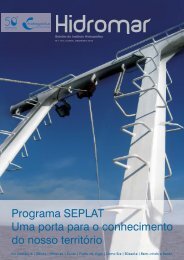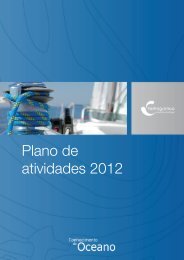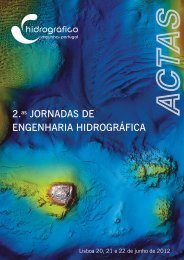Create successful ePaper yourself
Turn your PDF publications into a flip-book with our unique Google optimized e-Paper software.
Pre-processing and Post-processing of Model<br />
Wave Data in the Nearshore<br />
Eugen Rusu<br />
PROFESSOR ( 1 )<br />
Ventura Soares<br />
CAPITÃO-TENENTE ( 2 )<br />
Resumo O presente artigo surge motiva<strong>do</strong> pelo crescente interesse da Marinha Portuguesa em obter parâmetros de<br />
ondulação a partir de modelos de alta resolução, de mo<strong>do</strong> a que sirvam de suporte ambiental em operações anfíbias. São<br />
descritas duas ferramentas computacionais com base no software MATLAB. Estas ferramentas têm utilização em quase to<strong>do</strong>s<br />
os modelos costeiros, com especial interesse pela sua interactividade no âmbito <strong>do</strong> conceito <strong>do</strong> Rapid Environmental Assessment<br />
(REA) em regiões litorais. O modelo espectral de média em fase SWAN foi aqui usa<strong>do</strong> para exemplificação, da<strong>do</strong> que é,<br />
neste momento, a referência internacional neste tipo de modelos. O módulo de pré-processamento designa<strong>do</strong> por BARCO<br />
(acrónimo de BAthymetry Reshape and COnfigure) destina-se a visualizar a batimetria, graficar mapas e a gerar malhas,<br />
ten<strong>do</strong> em vista obter, de uma forma rápida, uma adequada caracterização da área de interesse. A ferramenta de pós-processamento<br />
proposta (TOTAL WAVE) é um interface com saídas numéricas e gráficas, que permite disponibilizar as condições<br />
de ondulação no litoral produzidas pelo modelo, bem como a previsão das condições de rebentação correspondentes a<br />
determinadas características de ondulação. A meto<strong>do</strong>logia proposta apresenta ainda uma importante vantagem que se<br />
consubstancia na redução <strong>do</strong> tempo de cálculo <strong>do</strong> modelo, da<strong>do</strong> o facto <strong>do</strong>s módulos referi<strong>do</strong>s calcularem previamente<br />
algumas das rotinas mais pesadas. O processo de desenvolvimento deste ambiente computacional tem em conta a possibilidade<br />
de estender a sua aplicação a sistemas de detecção remota.<br />
Abstract Motivated by the increasing interest of the Portuguese Navy in obtain results provided by the high-resolution<br />
models, as an environmental support in military nearshore and landing operations, the present paper describes two<br />
computational tools devised using the Matlab environment. They can be connected together with almost any coastal wave<br />
model and would be very useful both in the phase of implementation and calibration of the model as well as an interactive<br />
user-friendly tool for rapid environmental assessment in the littoral regions. Since the spectral phase averaging model<br />
SWAN was designated by most of the wave prediction programs as the community model in respect to shallow waters it<br />
was token also here as a reference. The pre-processing tool was named BARCO (acronym of BAthymetry Reshape and<br />
COnfigure) and its functions are to visualize bathymetries, plot maps and isomaps and to generate and reshape grids in<br />
order to achieve a quick and adequate selection of the area which is going to be processed. The proposed post-processing<br />
tool, named TOTAL WAVE, is an interface with graphical and numerical outputs that makes available the wave conditions<br />
in the nearshore as they are delivered by the model and gives a prediction to the surf zone conditions corresponding to the<br />
specific wave climate. The metho<strong>do</strong>logy proposed induce also as an important advantage a significant decreasing of the<br />
computational time of the model because of the number reduced of output requests by taken from the model some of the<br />
computational effort. In the process of the further development of this computational environment will be also taken into<br />
account the possibility of extending its capabilities from the wave models to the remote sensing systems.<br />
( 1 ) Professor at Galati University, Romania, Ph.D. in Marine Engineering, presently at <strong>Instituto</strong> <strong>Hidrográfico</strong>, Rua das Trinas, 49, 1249-093<br />
Lisbon, Portugal, eugene.rusu@hidrografico.pt.<br />
( 2 ) Head of Division of Oceanography, <strong>Instituto</strong> <strong>Hidrográfico</strong>, Rua das Trinas, 49, 1249-093 Lisbon, Portugal, ventura.soares@hidrografico.pt.



